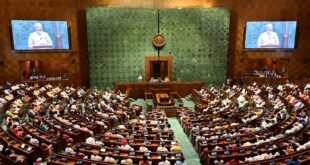Dr. Seema Javed
 A new paper, Fossil CO2 emissions in the post-COVID era’, is published March 3, 2021 published in Nature Climate Change, is the first global stock take by researchers that examines progress in cutting fossil CO2 emissions since the Paris Agreement was adopted in 2015. The result: 64 countries cut their fossil CO2 emissions during 2016-2019, but the rate of reduction needs to be ten times greater than current global efforts to meet the Paris Agreement and tackle climate change.
A new paper, Fossil CO2 emissions in the post-COVID era’, is published March 3, 2021 published in Nature Climate Change, is the first global stock take by researchers that examines progress in cutting fossil CO2 emissions since the Paris Agreement was adopted in 2015. The result: 64 countries cut their fossil CO2 emissions during 2016-2019, but the rate of reduction needs to be ten times greater than current global efforts to meet the Paris Agreement and tackle climate change.
This paper follows the recent UNFCCC NDC assessment on Feb 26 which found that we are on track for only 1% reduction in global emissions by 2030, compared to the 45% reduction needed to hit the 1.5°C temperature goal.
New research shows 64 countries cut their fossil CO2 emissions during 2016-2019, but the rate of reduction needs to increase tenfold to meet the Paris Agreement aims to tackle climate change.
This first global stock take by researchers at the University of East Anglia (UEA), Stanford University and the Global Carbon Project examined progress in cutting fossil CO2 emissions since the Paris Agreement was adopted in 2015. Their results show the clear need for far greater ambition ahead of the important UN climate summit in Glasgow in November (COP26).
The annual cuts of 0.16 billion tonnes of CO2 are only 10 per cent of the 1-2 billion tonnes of CO2 cuts that are needed globally every year to tackle climate change.
While emissions decreased in 64 countries, they increased in 150 countries. Globally, emissions grew by 0.21 billion tonnes of CO2 per year during 2016-2019 compared to 2011-2015.

The scientists’ findings, ‘Fossil CO2 emissions in the post-COVID era’, are published today in Nature Climate Change.
In 2020, confinement measures to tackle the COVID-19 pandemic cut global emissions by 2.6 billion tonnes of CO2, about 7 per cent below 2019 levels. The researchers say 2020 is a ‘pause button’ that cannot realistically continue while the world overwhelmingly relies on fossil fuels, and confinement policies are neither a sustainable nor desirable solution to the climate crisis.
Prof Corinne Le Quéré, Royal Society Professor at UEA’s School of Environmental Sciences, led the analysis. She said: “Countries’ efforts to cut CO2 emissions since the Paris Agreement are starting to pay off, but actions are not large-scale enough yet and emissions are still increasing in way too many countries.
“The drop in CO2 emissions from responses to COVID-19 highlights the scale of actions and of international adherence needed to tackle climate change. Now we need large-scale actions that are good for human health and good for the planet.
“It is in everyone’s best interests to build back better to speed the urgent transition to clean energy.”
Annual cuts of 1-2 billion tones of CO2 are needed throughout the 2020s and beyond to avoid exceeding global warming within the range 1.5 °C to well below 2 °C, the ambition of the UN Paris Agreement. The world has warmed by over 1 °C since the Industrial Revolution because of emissions of greenhouse gases from human activities.
Of the 36 high-income countries, 25 saw their emissions decrease during 2016-2019 compared to 2011-2015, including the USA (mean annual decrease of -0.7 per cent), the European Union (-0.9 per cent), and the UK (-3.6 per cent). Emissions decreased even when accounting for the carbon footprint of imported goods produced in other countries.
Thirty of 99 upper-middle income countries also saw their emissions decrease during 2016–2019 compared to 2011–2015, suggesting that actions to reduce emissions are now in motion in many countries worldwide. Mexico (-1.3 per cent) is a notable example in that group, while China’s emissions increased 0.4 per cent, much less than the 6.2 per cent annual growth of 2011-2015.
The growing number of climate change laws and policies appear to have played a key role in curbing the growth in emissions during 2016-2019. There are now more than 2000 climate laws and policies worldwide.
A full bounce-back in 2021 to previous CO2 emission levels appears unlikely.
However, the authors say unless the COVID-19 recovery directs investments in clean energy and the green economy, emissions will likely start increasing again within a few years. The nature of the disruption in 2020, particularly affecting road transport, means incentive to expedite the large-scale deployment of electric vehicles and encourage walking and cycling in cities are timely and would also improve public health. The resilience of renewable energy throughout the crisis, falling costs, and air quality benefits, are additional incentives to support their large-scale deployment.
Investments post-COVID continue to be overwhelmingly dominated by fossil fuels in most countries, in contradiction with climate commitments, including in the United States and China. The European Union, Denmark, France, the United Kingdom, Germany and Switzerland are among the few countries that have so far implemented substantial green stimulus packages with limited investments in fossil-based activities.
Prof Rob Jackson of Stanford University co-authored the study. He said: “The growing commitments by countries to reach net zero emissions within decades strengthens the climate ambition needed at COP26 in Glasgow. Greater ambition is now backed by leaders of the three biggest emitters: China, the United States, and the European Commission.”
“Commitments alone aren’t enough. Countries need to align post-COVID incentives with climate targets this decade, based on sound science and credible implementation plans.”
Prof Le Quéré added: “This pressing timeline is constantly underscored by the rapid unfolding of extreme climate impacts worldwide.” Anthony De-Gol at UEA has created an application that enables emissions data to be shown by country: https://enactivescience.com/gcp/
The Global Carbon Project is an international research project within the Future Earth research initiative on global sustainability, and a research partner of the World Climate Research Programme. It aims to develop a complete picture of the global carbon cycle, including both its biophysical and human dimensions together with the interactions and feedbacks between them. The Global Carbon Budget 2020 is the 15th edition of the annual update that started in 2006.
(Author is Environmentalist, Independent Journalist & Communication Consultant)
 Jubilee Post News & Views
Jubilee Post News & Views





